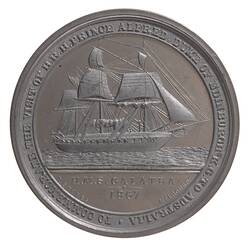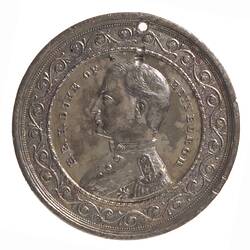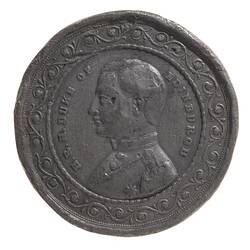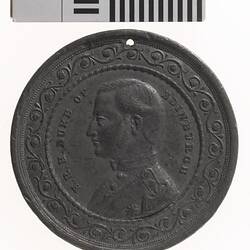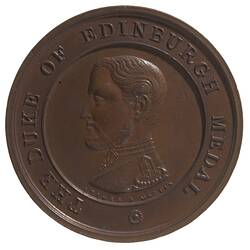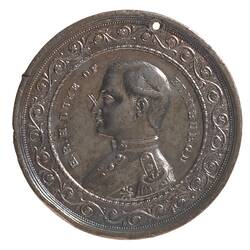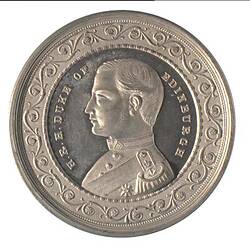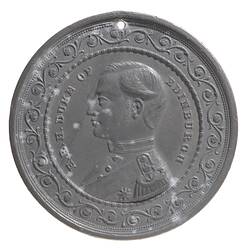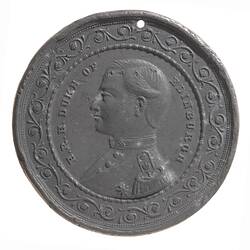The fourth child and second son of Queen Victoria and Prince Albert, Prince Alfred was born in Windsor Castle in 1844. He entered the navy and made a good impression, and was offered the position of King of Greece when Otto abdicated in 1862; the British Government declined on his behalf.
In 1867-68 he became the first British royal to visit Australia, staying for six months. Alfred received an enthusiastic welcome. Religious groups competed with each other to welcome him to Melbourne, with the Protestant Hall displaying a brightly lit tableau of William of Orange smiting the Catholic armies. Irish Catholics rioted outside the Hall and tragically a boy was killed. Public attention was distracted by a feast organised for 10,000 people on the banks of the Yarra. Unfortunately, 40,000 people had arrived before the food was ready, and the Prince cancelled his attendance for fear of being trampled. This upset the crowd, which stormed the barriers and fell upon the food and wine. Tents collapsed, wine buckets were snatched and mayhem ensued. The Sydney press gloated over the disaster.
Not to be outdone, Geelong also arranged free food in its Botanic Gardens. A massive crowd again gathered, and the organisers panicked and fled the scene. In Bendigo a large model of Alfred's ship Galatea, the centrepiece for a fireworks display, caught fire when three boys were climbing on it. They were trapped under the sails and burned to death. Alfred cancelled his activities and went into mourning. Two days later Bendigo returned to its programme with a ball in the new Alfred Hall, named after the Prince. It was a timber building, decorated with painted calico sheets. When the gas lamps were lit the calico caught fire and the building burnt down.
Back in Melbourne, the bad luck continued. A military display was held at the Flemington Racecourse, and a sailor loading a cannon had his hand blown off. The entourage decamped to Sydney, anticipating better luck, but at another public appearance the Prince was shot by a person in the crowd, later identified as Henry James O'Farrell. The crowd tried to lynch O'Farrell but were driven off by the police. Meanwhile the Prince was spirited away, to be treated by nurses selected by Florence Nightingale to work in the Sydney Infirmary, who had arrived in Australia just one week earlier. For all of its incidents, the tour was considered a great success, and helped to create a sense of unity for the young colony.
A skilled and efficient naval tactician, the Prince was promoted rear-admiral in 1878, vice-admiral in 1882, admiral in 1887, and received his baton as Admiral of the Fleet, 3 June 1893. Between 1893 and 1900 he was also Duke of Saxe-Coburg and Gotha, his brother having renounced that title. Although regarded as a foreigner by his subjects, he nevertheless won acceptance in this role.
The Prince married the Grand-Duchess Marie Alexandrovna, only daughter of Alexander II, Emperor of Russia, in St Petersburg in 1874. The marriage was not a happy one, and the bride was considered haughty by London society.
Some sources suggest that Prince Alfred supplemented his income by charging introductions to his relatives, including his brother, the Prince of Wales and future King (Edward VIII). It is also suggested that he was an alcoholic. Certainly, the family faced scandals. The Duke's only son, Prince Alfred, became involved with a mistress and shot himself in January 1899 at his parents' 25th wedding anniversary celebrations. He survived, but his embarrassed parents sent him away to recover, where he died two weeks later. This proved the last straw in the Duke and Duchess's troubled marriage, and Alfred drank himself to death over the course of the next year, dying in 1900.
References:
Wikipedia Encyclopaedia website http://www.wikipedia.org/wiki/Alfred,_Duke_of_Saxe-Coburg_and_Gotha
Faringdon-Davis, Gillian. 1988. The Monarchy and its Part in Australia's Maturity. Australian Numismatist. pp. 68-83
LORD BALMORE'S DESPATCH ON THE ATTEMPTED ASSASSINATION OF THE DUKE OF EDINBURGH. (1868, August 8). The Argus (Melbourne, Vic. : 1848 - 1957), p. 7. Retrieved October 17, 2013, from http://nla.gov.au/nla.news-article5823811
More Information
-
Keywords
-
Localities
-
Authors
-
Article types


